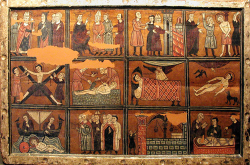St. Vincent Cross
The image on the left was inspired by the coat of arms of Lisbon, Portugal, which in turn was inspired by medieval Spanish art, as was the logo of the St Vincent's Anglican Chaplaincy in the Algarve.
Birds are a main feature, but unlike Lisbon's coat of arms and the chaplaincy's logo, the St. Vincent Cross is an X-shaped Ragulée.
St. Vincent
Vincent was born in the 3rd century in Huesca and lived in Zaragoza (now NE Spain). He is often referred to as Vincent of Huesca, Vincent of Zaragoza (English: Saragossa), Vincent the Deacon, and Vincent Martyr.
He became deacon to his mentor, Valerius, Bishop of Zaragoza, who had a speech impediment and Vincent would speak on his behalf. It is supposed that Vincent amplified the bishop's words, which caused concern to Emperor Diocletian, always wary of any perceived threat to his power and influence. And well might he have been concerned – despite his wealth and power, there is no way he could compete with the Word of God.
Valerius was exiled and Vincent was imprisoned in Valencia. Had they lived under the rule of Constantine I, five emperors later, he might have escaped the persecution which resulted in his death in the year 305.
The story handed down the centuries explains how Vincent was at first 'educated' (tortured) to see the error of his beliefs and was invited to renounce his faith. He was to prove his repentance by burning his religious books. He refused, and consequently he himself was tormented on the fire's iron grille and further punished by being dragged naked over sharp stones and broken pottery. His resilience and fortitude resulted in the conversion of the prison guard, who repaid Vincent with kindness and made him as comfortable as possible.
When the emperor received word that Vincent's faith had strengthened rather than weakened, he fumed with exasperation. He decided to play Vincent at his own game and show compassion. Vincent was moved from the dank cell to a sumptuous room where he could be pampered with soft and comfortable furnishings.
And there he died, having completed the vocation that God had granted.
St Vincent's Cross
The cross we have chosen for the above image is a Cross Ragulée, the de facto cross of Spain for several hundred years and also the St. Andrew's Cross shape depicted in medieval art of the rack used to torture Vincent. Fire grates, broken pottery and a millstone are also commonly seen in art featuring the saint.
And the birds?
As was the custom, his corpse was dumped in the open air to be devoured by vultures.
If you visit a city waste dump today you'll probably see scavengers circling over the debris. They might be satisfied with the rotting filth but for you an me, it's not a place for a summer picnic. Noise, stench, utter abandonment. Yet it was in such a place that Vincent's body was dumped; and it was here that angels appeared in the guise as ravens, which protected Vincent's body from being devoured.
So the dacian (Roman prefect) had the body tied to a millstone and thrown into the sea.
The frieze on the right (Click image to enlarge) shows the life and martyrdom of Saint Vincent. It's by an unknown artist and can be seen in front of the altar of the medieval church of Santa Maria del Monte, 20 minutes stroll northeast from the village of Liesa, near Huesca, Spain. The bottom left section shows ravens on the boat, watching as the saint's body is recovered by sympathisers and buried in Valencia.
Another version of the story relates the miracle of his body floating back to the shore, where a pious woman took the remains for burial in Valencia. A chapel was later built over the site.
In 1175, Vincent's relics were shipped to Lisbon and elsewhere.
Conclusion
We can learn from Vincent's biography that persecution can be overcome. It is unlikely that we will suffer as much as Vincent did, yet whatever temptation may present itself to break our faith, Christ is there to help us.
Sources: Heiligen-Lexicon, Johann Evangelist Stadler, Augsburg [1861]; Lives of the Saints Alban Butler, Benziger Bros. ed. [1894], sacred-texts.com/...
John 16:33





